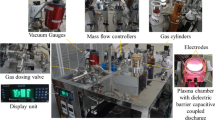Abstract
An ultra-precision polishing method using magnetorheological (MR) fluids is applied to the powder blasted micro channels fabricated on fused silica glass to improve surface quality and recover optical transmittance. For the experiments, 300 μm micro channels with 600 μm square reservoirs were fabricated on the glass; then, a series of MR polishing were performed. The surface roughness and transmittance of the micro channels rapidly improved after 20 minutes MR polishing. The Measured surface roughness of the final specimen was Ra = 2.2 nm, and transmittance was 99.38% (at wavelength = 1600 nm) of the original specimen. The results of this research confirm that the MR polishing can be a very effective method to improve surface roughness and transmittance by polishing the micro channels on fused silica glass.
Similar content being viewed by others
References
Belloy, E., Thurre, S., Walckiers, E., Sayah, A., and Gijs, M. A. M., “The introduction of powder blasting for sensor and microsystem applications,” Sens. Actuator A-Phys., Vol. 84, pp. 330–337, 2000.
Solignac, D., Sayah, A., Constantin, S., Freitag, R., and Gijs, M. A. M., “Powder blasting for the realization of microchips for bioanalytic applications,” Sens. Actuator A-Phys., Vol. 92, pp. 388–393, 2001.
Pu, Q. S., Luttge, R., Gardeniers, H. J. G. E., and Berg, A., “Comparison of capillary zone electrophoresis performance of powder-blasted and hydrogen fluoride-etched microchannels in glass,” Electrophoresis, Vol. 24, pp. 162–171, 2003.
Shin, Y. H., Shen, Y. K., Lin, Y., Ou, K. L., Hong, R. H., and Hsu, S. C., “Microfluidic Chip Fabrication by Micro-powder Blasting,” Nano/Micro Engineered and Molecular Systems, pp. 780–783, 2008.
Jang, H. S., Cho, M. W., and Park, D. S., “Micro Fluidic Channel Machining on Fused Silica Glass Using Powder Blasting,” Sensors, Vol. 8, pp. 700–710, 2008.
Golini, D., Kordonski, W. I., and Dumas, P., “Magnetorheological finishing(MRF) in commercial precision optics manufacturing,” Optical Manufacturing and Testing, Vol. 3782, pp. 80–91, 1999.
Shorey, A. B., Jacobs, S. D., Kordonski, W. I., and Gans, R. F., “Understanding the Mechanism of Glass Removal in Magnetorheological Finishing,” LLE Review, Vol. 83, pp. 157–172, 2000.
Shorey, A. B., Jacobs, S. D., Kordonski, W. I., and Gans, R. F., “Experiments and observations regarding the mechanisms of glass removal in Magnetorheological finishing,” Appl. Optics., Vol. 40, pp. 20–33, 2001.
Sidpara, A. and Jain, V. K., “Experimental investigations into surface roughness and yield stress in magnetorheological fluid based nano-finishing process,” Int. J. Precis. Eng. Manuf., Vol. 13, No. 6, pp. 855–860, 2012.
Kim, T. W. and Kwak, J. S., “A study on deburring of magnesium alloy plate by magnetic abrasive polishing,” Int. J. Precis. Eng. Manuf., Vol. 11, No. 2, pp. 189–194, 2010.
Jacobs, S. D., “Manipulating mechanics and chemistry in precision optics finishing,” Sci. Technol. Adv. Mater., pp. 153–157, 2007.
Kim, D. W., Cho, M. W., Seo, T. I., and Shin, Y. J., “Experimental Study on the Effects of Alumina Abrasive Particle Behavior in MR Polishing for MEMS Applications,” Sensors, Vol. 8, pp. 225–235, 2008.
Larena, A., Millan, F., Perez, G., and Pinto, G., “Effect of surface roughness on the optical properties of multilayer polymer films,” Appl. Surf. Sci., Vol. 187, pp. 339–346, 2002.
Retherford, R. S., Sabia, R., and Sokira, V. P., “Effect of surface quality on transmission performance for (111) CaF2,” Appl. Surf. Sci., Vol. 183, pp. 264–269, 2001.
Wang, Z., Wu, Y., Dai, Y., and Li, S., “Subsurface damage distribution in the lapping process,” Appl. Optics., Vol. 47, pp. 1417–1426, 2008.
Li, Y., Hou, J., Xu, Q., Wang, J., Yang, W., and Guo, Y., “The Characteristics of Optics polished with a polyurethane pad,” Opt. Express, Vol. 16, pp. 10285–10293, 2008.
Xu, S., Zheng, W., Yuan, X., Lv, H., and Zu, X., “Recovery of fused silica surface damage resistance by ion beam etching,” Nucl. Instrum. Methods Phys. Res. Sect. B., Vol. 266, No. 15, pp. 3370–3374, 2008.
Author information
Authors and Affiliations
Corresponding author
Rights and permissions
About this article
Cite this article
Lee, JW., Cho, YK., Cho, MW. et al. Optical transmittance recovery of powder blasted micro fluidic channels on fused silica glass using MR polishing. Int. J. Precis. Eng. Manuf. 13, 1925–1930 (2012). https://doi.org/10.1007/s12541-012-0254-5
Received:
Accepted:
Published:
Issue Date:
DOI: https://doi.org/10.1007/s12541-012-0254-5




